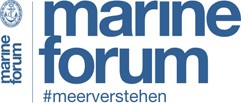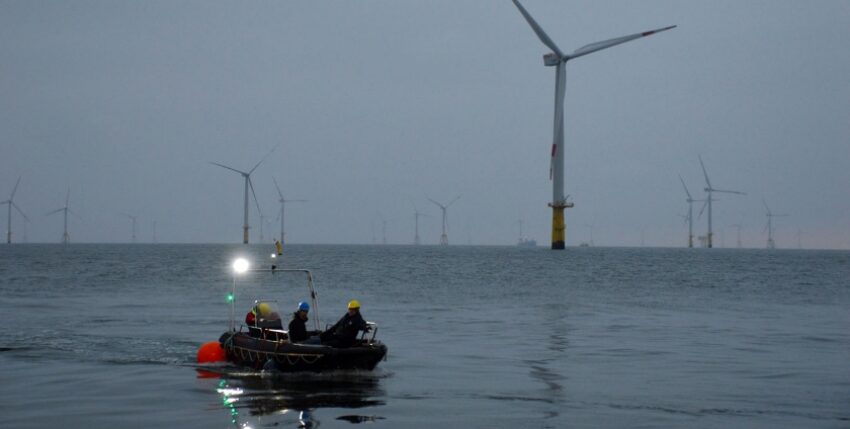The sea is no longer limitless: researchers want to optimise the use of increasingly scarce space at sea. But so far, the technology is not playing ball.
In the past, the sea seemed limitless to many people. Today, space is becoming scarce in some places at sea: merchant ships and the navy, fishing and aquaculture, tourists and water sports enthusiasts, energy producers and nature conservation all need space. Researchers are therefore exploring the multiple utilisation of marine areas. One example is the cultivation of algae and mussels in an offshore wind farm.
Chiara Sickert squats next to a cool box containing salt water and twelve green nets. The biology student is wearing a lifejacket over her anorak, a headband and a hood. It is freezing cold on this February morning on the North Sea.
Sickert is on deck on the Taifun. The blue and white multi-purpose vessel, a former buoy layer, set off from Helgoland at around half past four in the morning for the Meerwind Süd | Ost offshore wind farm. In addition to the crew and Sickert, who is studying at the Alfred Wegener Institute (AWI) for Polar and Marine Research in Bremerhaven, there are four other colleagues from the AWI on board.
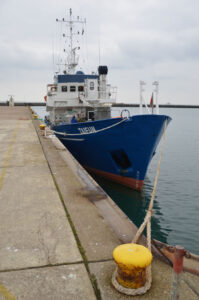
However, the main players on the trip are waiting in the cool box. Before the trip, Sickert and a fellow student spread spores of the brown algae species Saccharina latissima, also known as sugar kelp, on the nets. They are barely visible to the naked eye. Attached to a special construction in the sea, they are supposed to grow and thrive.
Algae are "on the rise worldwide", explains Sickert during the journey. She refers to dried algae chips, leaves for sushi and healthy ingredients. Brown algae are rich in antioxidants, iron and iodine. Algae can therefore be found in cosmetics, as organic fertiliser and as a component of bioplastics, for example.
But why should they grow in an offshore wind farm? "Aquaculture on the coast has the extreme disadvantage that you are always competing for space," explains Sickert. So it seems to make sense to use multiple areas. The project in the North Sea is one of three in the EU's Olamur research programme.
One is theory, the other is practice. Something goes wrong on the first day and the Taifun has to turn back without having achieved anything. Fortunately, Helgoland, where the AWI has a branch, is only a good 20 kilometres away.
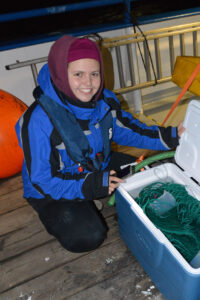
takes care of the brown algae, photo: Phillipp Steiner
Next day, new attempt. Arriving at the wind farm, Sickert and the cruise leader, Prof Bela H. Buck from the AWI, take the nets with the algae spores. They attach them to the Shellfish Tower with cable ties. "This is basically nothing more than a steel construction," explains Buck. In the centre of the hexagon is a two-metre-high, thick buoy. On two sides are rotating racks, to one of which the brown algae nets are attached. On a later trip, further racks will be used for breeding the European oyster Ostrea edulis, hence the name Shellfish Tower.
The project focuses on how algae and mussels cope with the conditions. After all, the European oyster normally lives on the seabed, says Wolf Isbert, another AWI researcher. In the wind farm, the mussels will thrive in the water column far above the bottom. "We don't yet know how they will cope with the movements," Isbert reveals. "And we also don't yet know what the plankton looks like, because they have to have enough food." After all, brown algae don't normally live on a metal structure in the middle of the water.
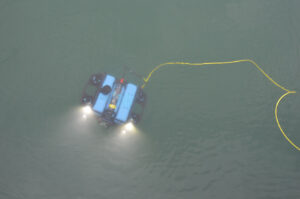
The project also explores whether the Shellfish Tower itself works. After all, you can't "buy something like this off the shelf", as Buck says. He developed the construction himself with colleagues from the AWI and researchers from New Zealand. In the end, the tower should float in the water at a depth of six to eight metres. Waves could damage it further up, and light could become scarce further down. The algae that photosynthesise need this to survive.
To ensure that the tower "floats" in the water, the buoyancy body pulls it upwards while it is connected to an anchor stone weighing several tonnes on the seabed - that is the plan. If this works, a whole series of similar towers with aquacultures could possibly be installed between the wind turbines or in other wind farms, thus alleviating the space problem at sea to a certain extent.
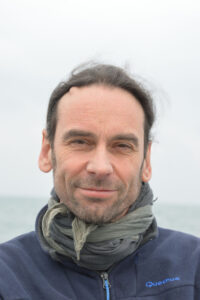
But in practice, things look different at first. Firstly, the anchor stone that had been deployed months ago could not be found. Hence the return journey to Helgoland, where a new anchor stone is hoisted on deck. During the attempt the next day, a chain breaks and the shellfish tower cannot be deployed as planned.
At midday on Saturday, after consulting with the captain, chief scientist Buck cancels the research mission for the time being. It is snowing as the Taifun sets course for Helgoland and later Cuxhaven. They want to try again in a few months, Buck announces in the cabin.
Dr Phillipp Steiner is a specialist journalist for the sea and shipping.
Phillipp Steiner
